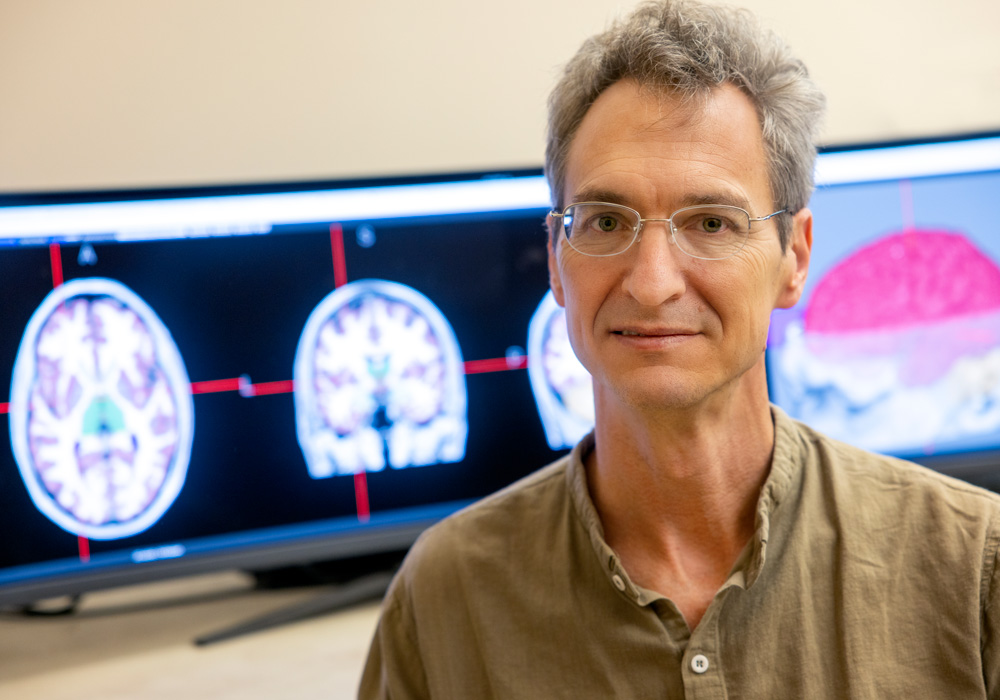There are two basic ways for scientists to make an impact in their field of study, and one of them is exceedingly difficult to pull off, says Chris Rorden, a psychology professor at the University of South Carolina who holds an endowed chair in neuroimaging.
“You can be super clever like Albert Einstein, but that’s pretty rare — there are not many Einsteins. The other way to be an influential scientist is to have a tool that no one’s had before that allows you to ask questions no one has asked,” says Rorden, who directs USC’s McCausland Brain Imaging Center in support of the university’s neuroscience research portfolio, including projects happening in the Aphasia Lab and the Center for the Study of Aphasia Recovery.
Rorden knows a few things about inventing influential research tools. The open-source MRIcron and MRIcroGL image processing software he developed, available for free online, has become the standard tool used by neuroscience researchers to visualize the healthy brain and map brain injuries.
Rorden points to Galileo, the 16th century Italian scientist who used the nascent popularity of the spyglass to make important contributions in astronomy and other fields. To that end, Rorden and other USC scientists are looking forward to the arrival of two new MRI machines for brain scanning that could lead to a better understanding of neurological disorders such as stroke-induced aphasia and dementia.
One of the scanners, an ultra-high field 7-Tesla, will allow researchers to see brain structure and function with much greater detail and clarity than is possible with the current suite of 3-Tesla scanners. The 7-T scanner will be used to help differentiate possible causes of a patient’s cognitive impairment and perhaps reveal other neurological disorders sometimes observed in combination with dementia. The scanner could also be used for the university’s ongoing research in aphasia, the loss of speech often associated with stroke.
“The 7-T looks like it's going to be very good for certain types of measurements of the brain and brain activity — very exquisite, high details of the structure of the brain in particular,” says Rorden, who has pioneered the development of MRI software tools that help neuroscientists using the scanners in their research. Rorden’s first faculty appointment was at the University of Nottingham in Great Britain where Sir Peter Mansfield helped build the world’s first 3-Tesla scanner nearly 25 years ago.
The second new scanner will be an extra-large 3-Tesla, matching the power and resolution of current scanners in the university’s brain imaging center but also expanding the population of patients who can be evaluated.
“There's quite a few people we can't image with our current 3-T because they simply don’t fit inside the scanner. We study stroke and dementia, and obesity is a risk factor for having such problems,” Rorden says. “If we have to say to 15 percent of the population, “We’re sorry, you can't qualify for our study because you don't fit into our scanners,’ we're excluding people who can add to the scientific knowledge about what’s happening with stroke and dementia and how we can treat it.”
The future scanners will be part of USC’s new Brain Health Center, which will be located in the 15 Medical Park building adjacent to the campus of Prisma Health Richland, one of the university’s principal clinical partners. Starting this fall, the building will begin undergoing renovations to accommodate the new MRI equipment and researchers for USC Brain Health, a state-funded initiative to focus physicians and researchers on solving cognitive health problems and reduce disparities in cognitive health care in South Carolina and beyond.
“Having a new campus and new equipment will attract more scientists,” Rorden says. “We’ve already brought in Leo Bonilha from Emory who is a rock star in using brain imaging to understand stroke and epilepsy. Our task now as a university is to recruit more scientists like that who can really leverage this new equipment and our Brain Health Center.
“I'm a facilitator, a tool maker for their research, and I'm looking forward to helping a lot of these people.”
